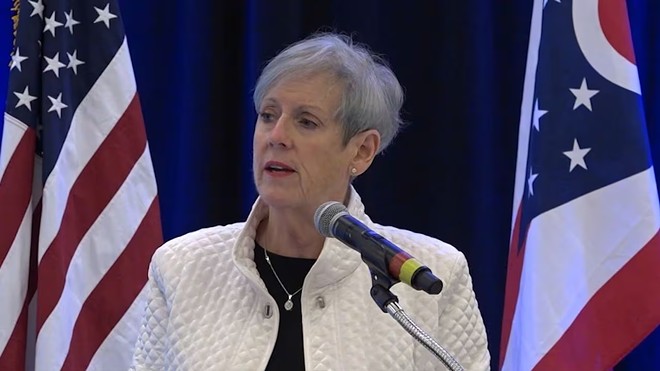In 2022, then-Ohio Supreme Court Chief Justice Maureen O’Connor sided with the court’s three Democratic justices in striking down gerrymandered congressional redistricting maps, leading some Republican legislators to call for her impeachment. Unable to run again in 2023 due to age limits, O’Connor left the bench as the longest-serving woman in Ohio elected office in state history.
Now working with Citizens Not Politicians, a coalition dedicated to ending gerrymandering through a state constitutional amendment, O’Connor spoke with Scene about the the group’s petition, political theater and fair congressional districts.
Scene: Clearly you’re still very involved in Ohio politics, but you did recently retire from the bench. How has that been?
O’Connor: I’m no longer a member of the Judiciary after 20 years on the Supreme Court and that allows me to be much more involved in things like redistricting and other initiatives that I’ve been involved with. I’m busier now, I think, than when I was on the bench, timewise, commitment-wise, I’ve got a lot going on, and it’s good.
It’s an opportunity to remain engaged but in a different way, and I say, right now, what I’m involved with, redistricting, if we can get this constitutional amendment passed, it will probably be the most important thing that I’ve done in my career is to be helpful in getting this amendment passed because it will put an end to gerrymandering, and gerrymandering is at the heart of what I think is problematic in the governance of Ohio and the country because we can’t forget that the constitutional amendment will affect not only the maps in Ohio for our general assembly, but also our congressional seats that we send to Washington. The margins are often razor-thin and that determines control of the House of Representatives, and with fair districts, we will strike a different balance.
Scene: Gerrymandering and the practice of manipulating congressional districts has a very long and sometimes absurd history in this country with both major political parties. In your career from an attorney to a magistrate to elected office, when did you become involved with the push for redistricting reform?
Well, I became involved, freely involved, I think the first meeting I had was January 5 of this year to get the constitutional amendment on, but I’ve been involved from the point of being on the court and either approving or not approving the maps that was just part of my job, just like the six other members of the Supreme Court. So that was a different involvement.
It was dispassionate. It was not political and it required not reflecting just my personal feelings or my personal views. It had to be grounded and supported legally so, again, I’ve been involved because it was my job and now I’m involved because it’s my vision to have this constitutional amendment and, when I say my vision, it’s not only my vision, but it’s a vision that I’m pursuing here to have this constitutional amendment on the ballot, which will be and to get it passed and implemented. It will change Ohio in ways that we don’t even know yet, but for the good.
Scene: You mentioned those district maps that had gone before the court that you had sided with Democratic justices on and then, towards the end of your tenure, some of your fellow Republicans called for your impeachment. Was that surprising to you?
I think I described it as a political theater. It was surprising that people in the legislature don’t know the constitution of the state that they’re in the third branch of or one of the three branches of government. It’s disheartening to think that this effort was even discussed. I understand that articles were drawn and it would have been embarrassing, more embarrassing, for them to have gone through with it because there were absolutely no grounds for impeachment. What are they going to say? “We don’t like your vote, waaah.” That’s not grounds for impeachment and, again, like my vote there were three others that voted right along with me and you’re not talking about them so clearly, this is just a political stunt. And that’s what it was.
Scene: A lot of that contention was, again, around these congressional districting maps, which has now kind of become your signature issue. Why is fair districting sort of what you’ve made a priority?
Well, it’s necessary. I mean, there’s no two ways about it. The timing and the need and my freedom, my ability to be involved here, all coincide, and so, that’s why I’m working on it now. That’s why it’s become something prominent and that’s why it will continue to be prominent until election day, November of ‘24.
Scene: You mentioned some state politicians not really being familiar with the actual Ohio Constitution, which does already prohibit redistricting plans that would, “Unduly favor or disfavor a political party or its incumbents.” And yet, these maps were brought before the court and you ruled against them. What makes the current language in the state constitution, not sufficient enough to stop partisan gerrymandering? And how will making it unconstitutional to draw voting districts that discriminate against or favor political parties or individuals change it?
Why is it not working now? Because the redistricting commission is made up of politicians. How will it change with the new amendment? The redistricting commission will not be made up of elected politicians. So therein lies the huge difference of the constitutional limits.
We have right now in the Constitution two amendments, one from 2015 one from 2018, one dealing with the legislature of Ohio one dealing with congressional elections. But the fingerprints all over it, the consequences are the redistricting commission which by the Constitution has the governor, an elected official; the Secretary of State, again, an elected official; the state auditor; and then four members of legislature, two from the majority party and two from the minority party.
And this is not it’s not bad because it’s an “R” thing. It’s bad because it’s both an “R” and a “D” [thing], Republican and Democrat, because both parties, both memberships, were motivated to get the best deal for their party so, for their interests, their jurisdictions, maintaining their jurisdictions, for the election and for the statewide, “Let’s make sure that our party is in control.” For the speaker and the president of the Senate, “Let’s make sure that we have maps that are going to give us a super majority so that we are invincible.”
And that’s not the right motivation for how you draw maps. You draw maps to be fair. You draw maps, ideally, that you’re not electing the extremes in either party, that people feel that they have a choice, that it’s competitive, that I’m gonna listen to both candidates and I’m going to make a decision and I know that my vote will matter, that whomever I vote for, even if I’m voting for someone who loses, they lost fairly to the opponent based on, again, competitive districts. And that, I think, that’s vitally important to how we shouldn’t be running the state.
That would encourage citizen participation in our government, encourage citizen participation in voting and I think that voting becomes a generational thing. You see your grandparents and your parents vote, it’s unheard of that you won’t vote, you won’t get to the polls. I couldn’t not get to the polls any more than I could chop off my hand. You just vote and it seems conceivable to me that people would say, “No, I’m not going to vote,” especially when we have really important issues. But I don’t think there’s any such thing as an off-year or election. There are things to vote for. People say, “Well, there’s nothing to vote for.” Yeah, there is. There always is.
Scene: It sounds like you would connect fair districting to voter participation and participation in democracy as a whole. When reading about the 2018 amendment, I saw that 70% of the people that voted did vote in support of it and then I saw in a statement for Citizens Not Politicians, that you’d called it, “Doomed to fail.” Is that, again, coming back to the fact that it’s politicians, and people with backgrounds with money in politics, on the committee or is there more to it than that?
No, it’s basic. You put politicians in, they’re going to do what politicians do. And the public officials are also politicians. You can do your job as a public official and you can do it without regard to your political party. And that’s when you’re wearing your public servant hat. That’s when you’re a public official.
But, there’s also the component that you are a politician and a politician brings in the concept of a party and participation by your party and you with the party. And so, if you’re on something like the redistricting commission, if that’s one one of your duties, constitutionally, you’re identified. The theory is that you’re going to be wearing your public servant hat, that you’re going to be fair and impartial in how you do your responsibilities. That’s a lot to ask for and the politician comes out, rather than the public servant officeholder, and the politician is what governs how the folks act and the work product that comes out of the redistricting commission. It’s political. It’s self interest. It’s party interest, and not when you wear your hat as a public servant as someone who is making decisions for the overall good of democracy.
You don’t see that in the makeup of our redistricting commission. The new amendment that we’re talking about is a citizen-populated, constitutional body redistricting commission. Five people who are registered Democrats, five registered Republicans and five who are registered with neither party. And there’s a whole list of folks who are ineligible to be on the commission. The commission’s work is intense. It’s expansive. It recognizes the importance of citizen input. Because they travel around the state in all four quadrants and then in central Ohio and receive evidence as to concerns that people have about their districts. Should their district be split? Is there a reason why they’re a community of interest and they should be retained, even though they’re not a geographically defined area? These are all considerations that have to be conclusions made by the redistricting commission, and then those conclusions are given to the map drawers.
And those are kind of the parameters, the guidepost for how they want to see maps drawn. And then that work product will be passed upon and implemented. And I think it’s very good. It’s well thought out, smart people worked on this amendment and I think it hits all the right notes.
Scene: Not specifically just this amendment, but with any attempt to reform gerrymandering, you have people opposing that say, “Well, no individual, no committee is unbiased.” Given that the constitutional amendment wouldn’t have elected members, what recourse do Ohioans have if a member fails to act in a fair, nonpartisan way?
Well, there’s 15 members of this commission, so there’s balance. When you say, “Is there somebody who’s not acting in a fair way?” I don’t know exactly what you mean by that. They’ll take an oath that here’s the only things that they’re going to consider and, if it comes out that they’re taking into consideration things that they shouldn’t be, they there won’t be a majority because the commission will be well vetted and be populated by people who are motivated to do the right thing, regardless of their politics.
For example, there’s a provision in there that if you’re on the redistricting commission, and someone approaches you and wants to influence your vote, you’ve got to call that out, you’ve got to identify it, you’ve got to record it and so there’s that transparency element. And that’s the other thing that is so beautiful about this amendment is everything will be done with a camera looking at it and live and so people can log on, they can watch what’s going on: the discussions, the testimony, the evidence has been put before the commission. And, again, they’re going around the entire state and the requirements are that they do that frequently, but in the evidence gathering, it will be done in a way that is citizen-friendly.
This last go around for drawing the maps, [The Ohio Redistricting Commission] went to some state park in the middle of the day. Our state parks are lovely. I’m not saying, “Don’t utilize state parks,” but let’s not do it when people are working and there’s no ability to have meaningful input. And things like that, I think, were done purposefully to minimize voter participation in those discussions. So, again, I think this amendment corrects all of the flaws that were in the other two amendments that I point to when I say they were doomed to fail from the beginning.
And here’s just one small example: there was a concentration on where current legislators lived. And so, you’ve got to take that into consideration, where they live now. Well, we’re going to take that into consideration. You want to preserve their district, you want to make sure that they’re not going to be in competition with another member who might, by happenstance, end up in the same district. God forbid we have something like that because we want incumbent A and incumbent B to continue to be incumbents and not have an election where their competitors.
This new amendment won’t even consider the residences of current members. That’s not relevant because they’re there by virtue of gerrymandered maps and you can’t have the fruit of those maps control what the new constitutional amendment will do.
Given that, in this past election, we saw considerable support for Issue One and Issue Two, which then, after election night, a swath of politicians came out against Issue One and said, basically, “We’re going to keep fighting this. We’re going to take action.” Do you feel like that is indicative of where Ohio is as far as representation?
You mean as far as disregard of the public will and directives and its, “We don’t work for the public, they work for us mentality”? Yeah, I think it is. I think that’s kind of what that meant.
I think that there was a lot of emotion and I don’t know that some of the some of the schemes that have been put forth, like removing the ability to have review of anything having to do with the Issue One constitutional amendment, removing the courts. That was something that was put up and I understand leadership in the legislature has said, “We’re not interested in doing that.” That was somebody saying that, again, in the heat of the moment, although I think they put pen to paper on that, but it can’t go anywhere.
Citizens Not Politicians Spokesperson Chris Davey: There was an interesting tweet today, if neither of you saw it, that I found quite surprising from David Yost, where he quoted the Ohio Constitution provision that says all powers are reserved to the people and basically said, “Any questions?” It was a repudiation from Dave Yost to these folks that are saying, “No, we’re not going to undo this.” I was surprised by that.
Well, I think that the handwriting is on the wall. This was 57% or 58% of the folks that voted for Issue One, the same margin in [the August special election], pretty much. And if you look at local elections, and I was just talking to some judges last night who were talking about conservative, Republican areas up north, outside of Cleveland communities for their city council, and others, went Democrat. In city councils where they never had Democrats before, Democrats got elected.
Now, what that means, I don’t know. Is it something that is indicative that they rode the coattails of voter turnout for Issue One, and that’s what happened? I don’t know. I think there’s a lot of political analysis that’s going to have to go into that, but that is pretty interesting. When you see the offices that are closest to the people–their city councils, their school boards, all of those–when you see that kind of a gravitational pull, it makes me wonder what’s going to happen next year in ’24. Are people not aware, the pundits, are they not aware of what happens in these kinds of elections? And if it’s happening, why is it happening? I don’t know.
Scene: So, assuming that Citizens Not Politicians can get the 413,000 signatures to get on the ballot in November, how do you see that election going?
Well, I don’t have a crystal ball but from how people reacted to the August election, how they came out and voted this November, I think we’re seeing a momentum. I hope that that momentum–I think that that will last and I think that there’s discussions that will be more prominent as we get closer to the election. I think that it’s going to pass. I think it’ll pass overwhelmingly. You’d be hard pressed to have an argument against it, saying, “No, we want to keep politicians. We want to keep people who have a political bias to them, and we think that’s a good thing.” You can’t make that argument.
There’s only one argument that I can think of, that we’ve heard: “This is an unaccountable bureaucracy that we don’t know which way it’s going go,” and etcetera. But the Constitution, if you read it, there’s built-in ceilings, for funding, for example. This isn’t going to be a runaway train with unaccountable actions by this group or a fiscal repercussion. It’s tied to how much money the redistricting commission spent in ’22 So, we’ve kind of, I think, thought of everything and what kind of argument could be made and how we can make the constitutional amendment better in anticipation so that those arguments can’t be made, and I think that I think that it’s going to be a common sense response. I really do.
Subscribe to Cleveland Scene newsletters.
Follow us: Apple News | Google News | NewsBreak | Reddit | Instagram | Facebook | Twitter | Or sign up for our RSS Feed
This post was originally published on this site be sure to check out more of their content.







